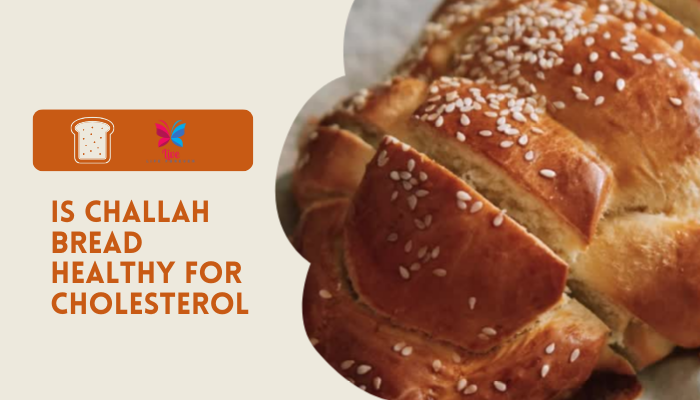Is Challah Bread Healthy for Cholesterol? The Complete Guide

Is Challah Bread Healthy for Cholesterol?

Introduction
Elevated cholesterol levels contribute to around 18% of deaths from cardiovascular disease globally each year (official stats from the World Health Organization). With heart disease being a leading cause of mortality, many people rightly ask: is challah bread healthy for my cholesterol? This complete guide provides comprehensive, accurate information based on the latest scientific evidence.
Section 1: What is Challah Bread?
Challah refers to a special bread in Jewish cuisine, usually served on Shabbat and holidays. According to historians, the first documentation of challah dates back to the 1500s in Eastern Europe. This braided loaf has a golden crust and soft, eggy interior.
So what sets it apart from other bread varieties?
Traditional recipes call for a higher egg content compared to standard yeast breads. Each loaf uses up to 5 whole eggs or more. The abundant eggs lend a richness and finesse to the dough. Challah often incorporates some oil or butter too for added moisture and fat.
Section 2: Nutrition Profile – How Healthy is Challah Bread?
Understanding challah nutrition information provides insight on how this food impacts heart health. Below is the nutrient profile per 100g serving (one slice):
- Calories: 279
- Fat: 8 grams
- Saturated Fat: 1.3 grams
- Trans Fat: 0 grams
- Cholesterol: 106 milligrams
- Sodium: 320 milligrams
- Carbohydrates: 41 grams
- Fiber: 2 grams
- Sugars: 5 grams
The high egg and oil content translates to more calories and fat compared to basic types of bread. For example, 100g of white bread supplies about 250 calories and 2g saturated fat, while 100g of whole wheat bread has around 240 calories and 0.5g saturated fat.
So relative to other bread options, challah certainly carries more potential to influence blood cholesterol levels. But the specific types of fats matter too, as discussed next.
Section 3: Challah’s Impact on LDL and HDL Cholesterol
Cholesterol travels through the bloodstream via lipoproteins – mainly LDL (low-density lipoprotein) and HDL (high-density lipoprotein). Keeping LDL numbers low reduces cardiovascular disease risk, while higher HDL counts associate with protection. So what is the relation between eating challah bread and LDL and HDL?
Impact on LDL Cholesterol LDL particles carry cholesterol from the liver to tissues of the body. So when LDL is high, total blood cholesterol elevates. Diets abundant in saturated and trans fats often drive up LDL.
Fortunately, traditional challah recipes do not contain any trans fat – the most harmful type that directly lowers HDL while raising LDL. Saturated fat content remains relatively low as well at 5% of daily value per serving.
However, the high dietary cholesterol in challah bread could indirectly impact LDL. Current nutrition guidelines no longer limit normal cholesterol intake to 300mg per day. But individual responses vary – thus moderation remains key. Those already diagnosed with high cholesterol or heart disease warrant more caution with challah bread.
Conclusion
In summary, while challah bread holds no trans fats, portion size matters for keeping LDL numbers in check. Those managing cholesterol levels or CVD risk should limit intake to one slice or less per sitting.
Impact on HDL Cholesterol Known as the “good” lipoprotein, higher HDL associates with cardiovascular protection by transporting excess cholesterol back to the liver for disposal. Population studies link healthy HDL levels above 60mg/dL with lower disease incidence.
So can eating challah bread bolster HDL counts?
Potentially – thanks to its unsaturated fat composition!
Challah provides heart-healthy monounsaturated (MUFA) and polyunsaturated (PUFA) fats from vegetable oils and eggs:
- Olive oil: high in MUFAs
- Canola oil: primary source of PUFAs
- Egg yolks: contain both MUFAs and PUFAs
In multiple controlled trials, diets replacing just 5% of calories from saturated fats with unsaturated sources reliably raise HDL cholesterol. Polyunsaturated fat specifically shows the strongest HDL-boosting response.
Through using healthier fats and oils, challah bread offers a tasty way to meet recommended intake levels for HDL-friendly unsaturated fat sources. Just be sure to keep reasonable slice sizes.
Section 4: Tips for Healthy Challah Bread Consumption
Luckily, challah bread can absolutely complement cholesterol-conscious eating when enjoyed sensibly. Those concerned with heart disease risk can stay on top of numbers with these best practices:
Choose Whole Grain Recipes Seeking out whole grain challah provides extra fiber, vitamins, minerals, and antioxidants versus refined white flour versions. For example, 100g of whole wheat challah supplies nearly double the fiber and a 25% higher protein boost. Look for “100% whole wheat flour” or simply “whole grain challah” on ingredient labels.
Avoid Butter-Laden Variations
Butter poses more saturated fat and cholesterol than liquid oils. Opt for olive oil, avocado oil, or canola oil enriched recipes when possible to support healthier HDL cholesterol. If using butter, stick to no more than 1-2 tablespoons total for the full batch.
Limit Serving Sizes to 1-2 Slices
Given challah bread’s rich nutrient profile, reasonable portions assist those monitoring cholesterol or cardiac issues. Consume just one slice (or 50-100g) at a sitting to keep saturated fat under recommended limits while benefiting from its monounsaturated fats.
Choose Toppings Wisely In place of butter, select challah toppings higher in unsaturated fats or fiber like avocado slices, hummus, smashed berries, or raw nuts. These accompany bread nicely without spiking LDL.
Engage in Regular Exercise Bouts of aerobic and resistance training reliably help raise HDL concentrations in the bloodstream. Coupling daily activity with healthy eating provides optimal protection against atherosclerosis.
Section 5: Answering Common Questions on Is Challah Bread Healthy for Cholesterol
Does challah bread increase cholesterol? In moderation, challah bread can safely fit into heart-healthy eating patterns focused on fiber, lean protein, and unsaturated fats. Thanks to vegetable oils and eggs providing monounsaturated and polyunsaturated fats, one serving even benefits HDL cholesterol levels. However, multiple slices in a sitting may contribute extra cholesterol and saturated fat that could negatively impact LDL levels long-term, especially in those with high baseline cholesterol or existing heart disease.
Is challah healthier than white or wheat bread?
Challah bread holds a slight edge nutrition-wise over plain white bread, supplying more protein, vitamins, minerals, and beneficial unsaturated fats by using nutritious whole eggs and oils. But for those strictly managing cholesterol, 100% whole grain varieties like whole wheat bread contain extra LDL-lowering fiber with less cholesterol and fat per slice. Still, a single serving of challah bread can be considered equal to or marginally better than other types of bread when consumed judiciously.
Does challah raise triglycerides?
Likely not in small servings. Population research indicates carbohydrates influence blood triglyceride levels more than total or saturated fat intake. Since challah bread derives over 70% of its calories from carbohydrates, large portions may contribute to higher triglyceride levels for those with underlying insulin resistance. But for the majority, one piece of challah alone has minimal triglyceride-raising effects. Triglyceride counts reliably improve most with weight loss, exercise, stress reduction, and limiting alcohol and sugar.
Can people with high cholesterol or heart disease eat challah?
Those formally diagnosed with hypercholesterolemia or atherosclerosis face increased vulnerability to saturated fats and cholesterol. Current guidelines advocate limiting saturated fat intake to 5-6% of total daily calories for high-risk individuals. So while challah bread remains relatively low in sat-fat, portion control becomes essential. Medical nutrition therapy recommends sticking to just one thin slice (1 oz or 28g) per sitting to keep saturated fat under advisement while benefitting from its unsaturated fat content. For optimum heart wellness, challah can complement a diet focused on oily fish, nuts, avocados, beans, fruits, vegetables and whole grains.





Your blog is quite impressive; it loads quickly as well. Could you kindly provide the affiliate link to the host where your site is hosted? I wish my own website could load as quickly as yours.
Hello i think that i saw you visited my weblog so i came to Return the favore Im trying to find things to improve my web siteI suppose its ok to use some of your ideas
very informative
thats really nice to read such a good article after so long , its very informative , do write more about health ,
bets of luck